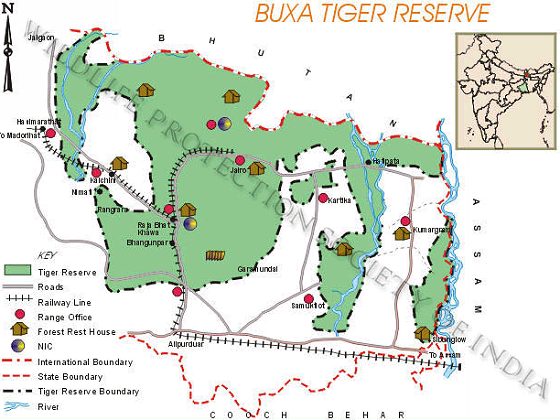Tiger Reserves
| |
|
|

|
|
Buxa
Tiger Reserve
|
|
State
|
West
Bengal
|
History
|
|
Altitude
(above M.S.L.)
|
125
- 1750 m
|
Buxa
serves as an international corridor for
the migration of elephants between India
and Bhutan. The Tiger Reserve was created
in 1983 but 117km² of the area was only
notified as a National Park in 1997.
|
|
Area
|
Total
|
760.9
km²
|
|
Core
|
385.0
km²
|
|
Buffer
|
375.9
km²
|
|
Flora
and Fauna
|
|
The
flora at Buxa is extremely diverse. Ten
forest types occur here and more that 1509
plant species have been identified. Some
of the important species are Sal, Champa,
Gamar, Simul and Chikrasi. A further 390
bird species, 73 mammal species, 76 different
snake species and 5 species of amphibians
have also been identified. There are an
estimated 33 tigers in the reserve.
|
|
Temperature
|
15°C
- 39°C
|
|
Rainfall
(per annum)
|
3570
- 5600 mm
|
|
Seasons
|
Winter
|
Oct
- Jan
|
|
Summer
|
Feb
-May
|
|
Monsoon
|
Jun
- Sep
|
|
Forest
Types
|
|
Northern
Dry Deciduous Forest, Eastern Bhabar, Terai
Sal, East Himalayan Moist Mixed Deciduous
Forest, Sub-Himalayan Secondary Wet Mixed
Forest, Eastern Sub-Montane Semi-Evergreen
Forest, Northern Tropical Evergreen Forest,
East Himalayan Subtropical Wet Hill Forest,
Moist Sal Savanna, Low Alluvium Savannah
Woodland
|
|
Fauna
|
|
Tiger,
elephant, leopard cat, gaur, wild boar,
sambar, hog deer, Chinese pangolin, etc.
|
|
Funds
|
Flow
is not a problem
|
Management
Objectives
|
|
Staff
|
Untrained
& understaffed
|
Protection
and habitat management are priority activities.
The felling of natural forests and cutting
of cane and bamboo as well as dolomite mining,
which was once prevalent in the area, are
no longer allowed at Buxa.
|
|
Problems
|
|
Soil
degradation and erosion, caused by mono-cultures
of teak and by fires, results in frequent
floods. There is also a lack of drinking
water at many locations in the reserve.
Grazing is a great menace at Buxa and weeds,
unpalatable grasses and shrubs have invaded
the over-grazed areas. Cattle carry diseases
such as Anthrax, Foot and Mouth Disease
and Haemorhapic Septicmis and Block Quarter
(HSBQ) to the reserve. Elephants and leopards
attack villagers periodically resulting
in injuries or death. Timber thieves are
active in the reserveand poaching also occurs.
|
|
External
Influences
(1991 census)
|
|
Human
Population
|
236,000
|
|
Livestock
numbers
|
100,000
|
|
 |
|